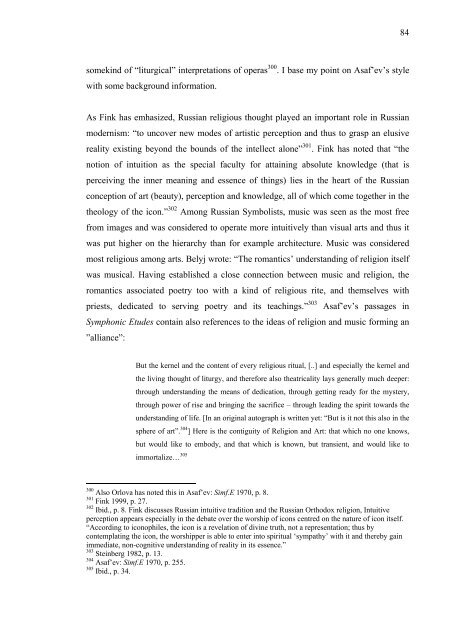Boris Asaf'ev and the Soviet Musicology - E-thesis
Boris Asaf'ev and the Soviet Musicology - E-thesis
Boris Asaf'ev and the Soviet Musicology - E-thesis
You also want an ePaper? Increase the reach of your titles
YUMPU automatically turns print PDFs into web optimized ePapers that Google loves.
somekind of “liturgical” interpretations of operas 300 . I base my point on Asaf’ev’s style<br />
with some background information.<br />
As Fink has emhasized, Russian religious thought played an important role in Russian<br />
modernism: “to uncover new modes of artistic perception <strong>and</strong> thus to grasp an elusive<br />
reality existing beyond <strong>the</strong> bounds of <strong>the</strong> intellect alone” 301 . Fink has noted that “<strong>the</strong><br />
notion of intuition as <strong>the</strong> special faculty for attaining absolute knowledge (that is<br />
perceiving <strong>the</strong> inner meaning <strong>and</strong> essence of things) lies in <strong>the</strong> heart of <strong>the</strong> Russian<br />
conception of art (beauty), perception <strong>and</strong> knowledge, all of which come toge<strong>the</strong>r in <strong>the</strong><br />
<strong>the</strong>ology of <strong>the</strong> icon.” 302 Among Russian Symbolists, music was seen as <strong>the</strong> most free<br />
from images <strong>and</strong> was considered to operate more intuitively than visual arts <strong>and</strong> thus it<br />
was put higher on <strong>the</strong> hierarchy than for example architecture. Music was considered<br />
most religious among arts. Belyj wrote: “The romantics’ underst<strong>and</strong>ing of religion itself<br />
was musical. Having established a close connection between music <strong>and</strong> religion, <strong>the</strong><br />
romantics associated poetry too with a kind of religious rite, <strong>and</strong> <strong>the</strong>mselves with<br />
priests, dedicated to serving poetry <strong>and</strong> its teachings.” 303 Asaf’ev’s passages in<br />
Symphonic Etudes contain also references to <strong>the</strong> ideas of religion <strong>and</strong> music forming an<br />
”alliance”:<br />
But <strong>the</strong> kernel <strong>and</strong> <strong>the</strong> content of every religious ritual, [..] <strong>and</strong> especially <strong>the</strong> kernel <strong>and</strong><br />
<strong>the</strong> living thought of liturgy, <strong>and</strong> <strong>the</strong>refore also <strong>the</strong>atricality lays generally much deeper:<br />
through underst<strong>and</strong>ing <strong>the</strong> means of dedication, through getting ready for <strong>the</strong> mystery,<br />
through power of rise <strong>and</strong> bringing <strong>the</strong> sacrifice – through leading <strong>the</strong> spirit towards <strong>the</strong><br />
underst<strong>and</strong>ing of life. [In an original autograph is written yet: “But is it not this also in <strong>the</strong><br />
sphere of art”. 304 ] Here is <strong>the</strong> contiguity of Religion <strong>and</strong> Art: that which no one knows,<br />
but would like to embody, <strong>and</strong> that which is known, but transient, <strong>and</strong> would like to<br />
immortalize… 305<br />
300<br />
Also Orlova has noted this in Asaf’ev: Simf.E 1970, p. 8.<br />
301<br />
Fink 1999, p. 27.<br />
302<br />
Ibid., p. 8. Fink discusses Russian intuitive tradition <strong>and</strong> <strong>the</strong> Russian Orthodox religion, Intuitive<br />
perception appears especially in <strong>the</strong> debate over <strong>the</strong> worship of icons centred on <strong>the</strong> nature of icon itself.<br />
“According to iconophiles, <strong>the</strong> icon is a revelation of divine truth, not a representation; thus by<br />
contemplating <strong>the</strong> icon, <strong>the</strong> worshipper is able to enter into spiritual ‘sympathy’ with it <strong>and</strong> <strong>the</strong>reby gain<br />
immediate, non-cognitive underst<strong>and</strong>ing of reality in its essence.”<br />
303<br />
Steinberg 1982, p. 13.<br />
304 Asaf’ev: Simf.E 1970, p. 255.<br />
305 Ibid., p. 34.<br />
84

















